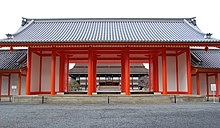Japanese imperial family
The Japanese imperial house ( Japanese 皇室 , kōshitsu; synonymous also imperial court and imperial family ; an alternative word that also means imperial house is 天 皇家 , tennōke ) includes the members of the incumbent Tennō's family who take on representative public duties, as well as their minors Children. According to the current Japanese constitution , the tennō is the symbol of the state and the unity of the people. The other members of the imperial family perform ceremonial and social duties, but have no function in government affairs.
The Japanese monarchy is the world's oldest uninterrupted hereditary monarchy. The imperial family has recognized 126 legitimate monarchs since Jimmu -tennō's accession to the throne . The sun kami Amaterasu-ō-mi-kami , who is said to have given Jimmu the order and authorization to rule Japan, is considered to be the ancestor .
Most historians attribute the first fourteen Tennō (Jimmu-tennō to Chūai -tennō) to a legendary character rather than a historical one. The currently ruling Tennō, Naruhito , is the 126th monarch in the official chronology.
Members of the Imperial Family
Current members
The Imperial Family Law of 1947 defines the Imperial Family as: the empress ( 皇后 , kōgō ), the imperial mother ( 皇太后 , kōtaigō ), the imperial grandmother ( 太 皇太后 , tai-kōtaigō ); the crown prince ( 皇太子 , kōtaishi ) and his wife, the imperial grandson, the heir to the throne ( 皇太孫 , kōtaison ) and his wife, the shinnō ( ihre ) and her spouse, the naishinnō ( 内 親王 ); the Ō ( 王 ) and their spouse, and the nyoō ( 女王 ). The legitimate children and grandchildren of the emperor's male line are shinnō (imperial princes) for men and naishinnō (imperial princesses) for women. More distant descendants of the male line are Ō (princes) or nyoō (princesses). See below for more information on these titles.
After eleven families were removed from the imperial house in October 1947, membership in the imperial house is effectively reduced to the descendants in the male line of the Taishō -tennō, with women who married outside the imperial house and their descendants being excluded.
- The emperor and the empress
| Salutation, title and proper name | Date of birth | Remarks | image |
|---|---|---|---|
| His Imperial Majesty Emperor Naruhito | February 23, 1960 | Son of Akihito and Michiko , emperor since May 1, 2019 |

|
| Her Imperial Majesty Empress Masako | December 9, 1963 | Wife of the emperor |
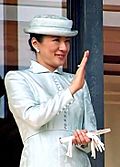
|
- The emperor emeritus and the empress emeritus
| Salutation, title and proper name | Date of birth | Remarks | image |
|---|---|---|---|
| His Imperial Majesty the Emeritus Emperor Akihito | December 23, 1933 | Son of Emperor Hirohito and Empress Kōjun , Emperor from January 7, 1989 to April 30, 2019 |

|
| Her Imperial Majesty the Emeritus Empress Michiko | October 20, 1934 | Wife of the emperor emeritus |

|
- Toshi branch
| Salutation, title and proper name | Date of birth | Remarks | image |
|---|---|---|---|
| Her Imperial Highness Princess Aiko | December 1, 2001 | Daughter of the emperor and the empress |

|
- Akishino branch
| Salutation, title and proper name | Date of birth | Remarks | image |
|---|---|---|---|
| His Imperial Highness Crown Prince Fumihito | November 30, 1965 | First place in the line of succession, brother of the emperor and brother-in-law of the empress |

|
| Her Imperial Highness Crown Princess Kiko | September 11, 1966 | Wife of Crown Prince Fumihito |

|
| Her Imperial Highness Princess Mako | October 23, 1991 | Daughter of Crown Prince Fumihito and Crown Princess Kiko |
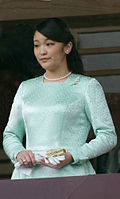
|
| Her Imperial Highness Princess Kako | December 29, 1994 | Daughter of Crown Prince Fumihito and Crown Princess Kiko |

|
| His Imperial Highness Prince Hisahito | September 6, 2006 | Rank 2 in the line of succession, son of Crown Prince Fumihito and Crown Princess Kiko |

|
- Hitachi branch
| Salutation, title and proper name | Date of birth | Remarks | image |
|---|---|---|---|
| His Imperial Highness Prince Masahito | November 28, 1935 | Rank 3 in the line of succession, brother of the emperor emeritus, uncle of the emperor |

|
| Her Imperial Highness Princess Hanako | July 19, 1940 | Wife of Prince Masahito |
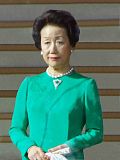
|
- Mikasa branch
| Salutation, title and proper name | Date of birth | Remarks | image |
|---|---|---|---|
| Her Imperial Highness Princess Yuriko | June 4, 1923 | Widow of Prince Takahito and mother of the late Princes Tomohito , Yoshihito and Norihito |
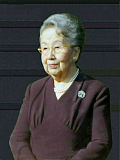
|
| Her Imperial Highness Princess Nobuko | April 9, 1955 | Widow of Prince Tomohito |
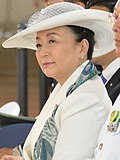
|
| Her Imperial Highness Princess Akiko | December 20, 1981 | Daughter of Prince Tomohito and Princess Nobuko |

|
| Her Imperial Highness Princess Yōko | October 25, 1983 | Daughter of Prince Tomohito and Princess Nobuko |

|
- Takamado branch
| Salutation, title and proper name | Date of birth | Remarks | image |
|---|---|---|---|
| Her Imperial Highness Princess Hisako | July 10, 1953 | Widow of Prince Norihito |

|
| Her Imperial Highness Princess Tsuguko | March 6, 1986 | Daughter of Prince Norihito and Princess Hisako |

|
Former branches of the imperial family
In the event of the death of a childless prince who has been given permission to set up his own branch, his name can only be carried on by his wife. After their death, the branch is dissolved, which has been the case with three since Emperor Taishō.
- Chichibu branch
| Salutation, title and proper name | Date of birth | date of death | Remarks | image |
|---|---|---|---|---|
| His Imperial Highness Prince Yasuhito | June 25, 1902 | 4th January 1953 | Son of Emperor Taishō and Empress Teimei |

|
| Her Imperial Highness Princess Setsuko | September 9, 1909 | August 25, 1995 | Wife of Prince Yasuhito |
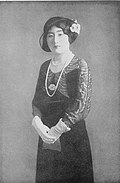
|
- Takamatsu Branch
| Salutation, title and proper name | Date of birth | date of death | Remarks | image |
|---|---|---|---|---|
| His Imperial Highness Prince Nobuhito | January 3, 1905 | 3rd February 1987 | Son of Emperor Taishō and Empress Teimei |

|
| Her Imperial Highness Princess Kikuko | December 26, 1911 | December 18, 2004 | Wife of Prince Nobuhito |

|
- Katsura branch
| Salutation, title and proper name | Date of birth | date of death | Remarks | image |
|---|---|---|---|---|
| HRH Prince Yoshihito | February 11, 1948 | June 8, 2014 | Son of Prince Takahito and Princess Yuriko, did not get married |

|
Resigned members
According to the law on the imperial family, female members leave the imperial house if they marry civilly. This is the case with the following former members:
| Bourgeois name | Date of birth | Remarks | image |
|---|---|---|---|
| Atsuko Ikeda | March 7, 1931 | Aunt of Emperor Naruhito |
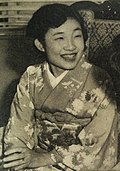
|
| Takako Shimazu | March 2, 1939 | Aunt of Emperor Naruhito |

|
| Yasuko Konoe | April 26, 1944 | Cousin of the emperor emeritus Akihito | |
| Masako Sen | October 23, 1951 | Cousin of the emperor emeritus Akihito | |
| Sayako Kuroda | April 18th 1969 | Sister of Emperor Naruhito |

|
| Noriko Senge | July 21, 1988 | Daughter of Prince Norihito |

|
| Ayako Moriya | September 15, 1990 | Daughter of Prince Norihito |

|
succession
Basics
Historically, the succession to Japan's chrysanthemum throne generally ran through male descendants of the imperial line. Some of the Imperial Japanese dynasty has their longevity cohabiting relationships owe, a practice that came to an end only in the Taisho period. The Japanese monarchy had certain subsidiary lines for this purpose ( 親王 家 , shinnōke ). If the imperial family remained without an inheritance, a shinnōke house could provide an heir to the throne. In the Edo period there were four of these branch lines: Fushimi , Katsura , Arisugawa , and Kan'in . Kōkaku-tennō (ruled 1780-1817), ancestor in the direct line of all subsequent Tennō, was a scion of the Kan'in house. The houses of Katsura and Arisugawa died out in 1881 and 1913, respectively. A descendant of the House of Fushimi became head of the House of Kan'in in 1884. The House of Fushimi is the lineage of nine other so-called princely houses ( 王家 , ōke ) of the Imperial Family during the Meiji period . This house and its offshoots were demoted to civil status in 1947.
Before the Meiji Restoration , Japan had eight female Tennō, ruling empresses. However, imperial daughters and granddaughters only ascended the throne as a "temporary solution". They all abdicated as soon as a suitable male successor to the male line was available. Three of these ruling female Tennō, Suiko -tennō, Kōgyoku -tennō, and Jitō -tennō, were widows of deceased male Tennō and princesses of imperial blood themselves. One, Genmei -tennō, was the crown prince's wife and imperial princess. The other four, Genshō -tennō, Kōken -tennō, Meishō -tennō and Go-Sakuramachi -tennō, were unmarried daughters of previous Tennō. None of these female Tennō married or gave birth to children after taking the throne.
Article 2 of the Meiji Constitution of 1889 states: “ The throne should be passed on to male imperial descendants, according to the provisions of the Imperial Family Act. “The Imperial Family Act of 1889 restricted succession to the throne to male descendants and explicitly excluded female descendants. In the event of the male line becoming extinct, the throne would go to the next branch line, also in the male line. If the Kōgō did not give birth to an heir to the throne, the Tennō could choose a concubine, and the son of that concubine would be recognized as the heir to the throne. This law, promulgated on the same day as the Meiji Constitution, had an equivalent status.
Article 2 of the Japanese Constitution states that “ the Imperial Throne should be dynastic in accordance with the Imperial Family Law passed by Parliament. “The Imperial Family Act of January 16, 1947, enacted at the 69th and final session of the Imperial Parliament, maintained the exclusion of female rulers from the 1889 Act. The government of Prime Minister Yoshida Shigeru hastily cobbled together the law to bring it into line with the American-written post-war constitution that went into effect in May 1947. In an effort to keep the size of the Imperial Family under control, the law states that only legitimate male descendants in the male line can inherit, that princesses lose their status if they marry outside the Imperial Family, and that the Emperor and other members of the imperial family are not allowed to adopt children.
A succession crisis loomed as no male child had been born in the imperial family since 1965. After the birth of Princess Aiko, there was public debate about changing the Imperial Family Act to allow women to accede to the throne. In January 2005, Prime Minister Koizumi Junichiro convened a commission of judges, university professors and civil servants to explore possible changes to the law and draft legislative proposals. One of the options was to allow women in the male line of imperial succession to be enthroned.
With Prince Hisahito , who, when he was born on September 6, 2006, took third place in the Japanese line of succession (and now has second place), the debate about the line of succession is over, at least for the time being.
Current succession
- His Imperial Highness Crown Prince Fumihito von Akishino, second son of the retired Tennō, brother of the present Tennō
- His Imperial Highness Prince Hisahito of Akishino, son of Crown Prince Akishino
- His Imperial Highness Prince Hitachi (Masahito), brother of the retired Tennō, uncle of the present Tennō
Emperor Naruhito has a daughter (Aiko), Crown Prince Akishino has two daughters (Mako and Kako) and, since September 6, 2006, also has a son (Hisahito). It is the first time since 1965 that a boy has been born into the Akihito family, whose dynasty otherwise threatened to die out in the male line. The Tennō's uncle, Prince Hitachi, is childless. Prince Mikasa (Takahito), uncle of the present Tennō, who died on October 27, 2016, took the place behind Prince Hitachi. Of his three sons, Prince Tomohito has two daughters (Akiko and Yōko), Prince Katsura is childless, and Prince Takamado has three daughters (Tsuguko, Noriko and Ayako).
History of the title
王 , read Ō and usually translated as prince , is the title that male members of the Imperial Family bear who do not bear the higher title Shinnō ( 親王 ). The female equivalent is Nyoō ( 女王 ). Historically, the character 王 can also be translated as king. This double meaning was carried over from Chinese to Japanese. Unlike in China, however , 王 was only used for members of the imperial family. Similarly, the characters of Nyoō can also be read Joō , which would then mean queen.
Before the Meiji period , every male member of the Imperial Family bore the title Ō, whereby Shinnō and the female equivalent Naishinnō ( 内 親王 , 内 stands for inside ) were special titles awarded by the emperor. After the Meiji Restoration , the meaning of Ō and Shinnō was changed. Shinnō and Naishinnō were legitimate descendants of a Tennō to great-grandson. In this case, “Legitim” excludes all those who are not descended directly from the male line, as well as the descendants of those who have given up their membership in the imperial house or have been excluded. The heads of the royal houses, the Shinnōke ( 親王 家 ), also carried the title Shinnō. A law that was never applied, however, said that should a head of a royal house ascend the chrysanthemum throne, his brothers and descendants would also be elevated to the rank of Shinno. The Tennō could also bestow the title Shinnō. After 1947 the law was changed so that only the children and grandchildren of the emperor were allowed to carry the title Shinno. The imperial family was further downsized by the fact that the Ōke and Shinnōke lost their status.
Since the amendment to the law on the imperial household in June 2017 as a result of Akihito's abdication, the titles Jōkō ( 上皇 ; "emperor emeritus") with the female equivalent Jōkōgō ( 上 皇后 , "empress emeritus") and Kōshi ( 皇嗣 , " Crown Prince ") or Kōshihi ( 皇嗣 妃 ," Crown Princess ").
The wife of a Ō or Shinnō adds the suffix -hi ( 妃 ) to her title, and is thus Ōhi or Shinnōhi.
Flags
Standard of the regent ( sesshō ), white outer edge
See also
Web links
- Official website of the Imperial Court Office (Japanese and English)
- Raymond Lamont-Brown: Japan's Imperial Family: Its Role And Meaning In Modern Japan . In: Contemporary Review , Vol. 275, No. 1604, September 1999 (English).
- Fan page ( Memento from February 1, 2008 in the Internet Archive )
- Chiara Beekvelt: No Empress for Japan? The Japanese Monarchy and Its Law of Succession . The article explains the political and historical background to the controversy behind the succession to the throne in Japan and summarizes the development of the discussion so far (as of January 2012).
Individual evidence
- ↑ kunaicho.go.jp - ご 称号 と お 代替 わ り の 基本 用語 (Japanese), accessed May 6, 2019


